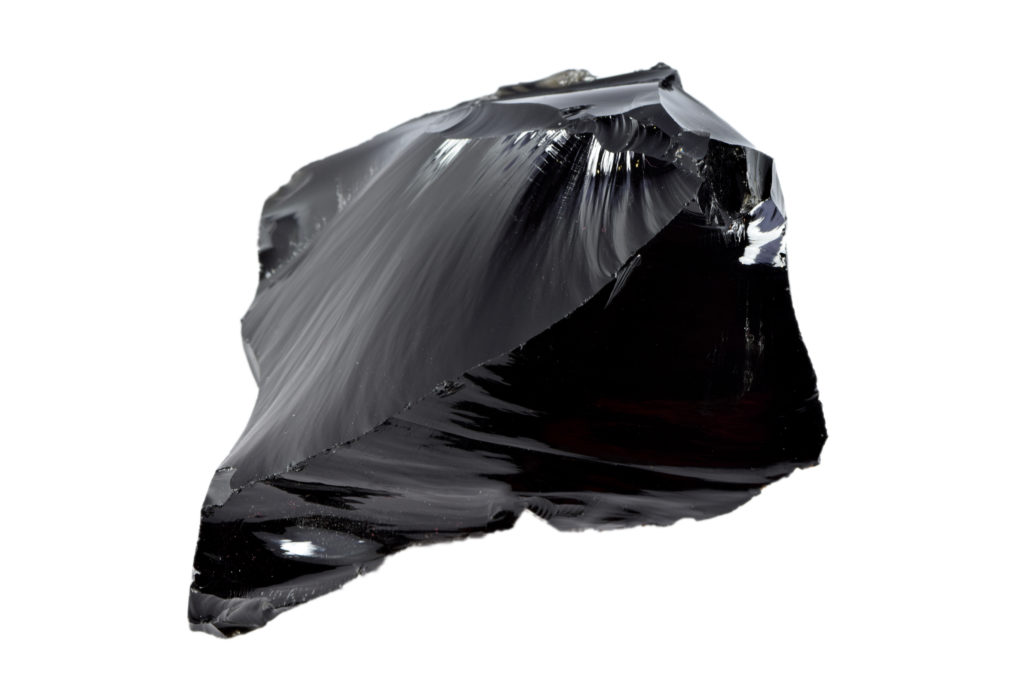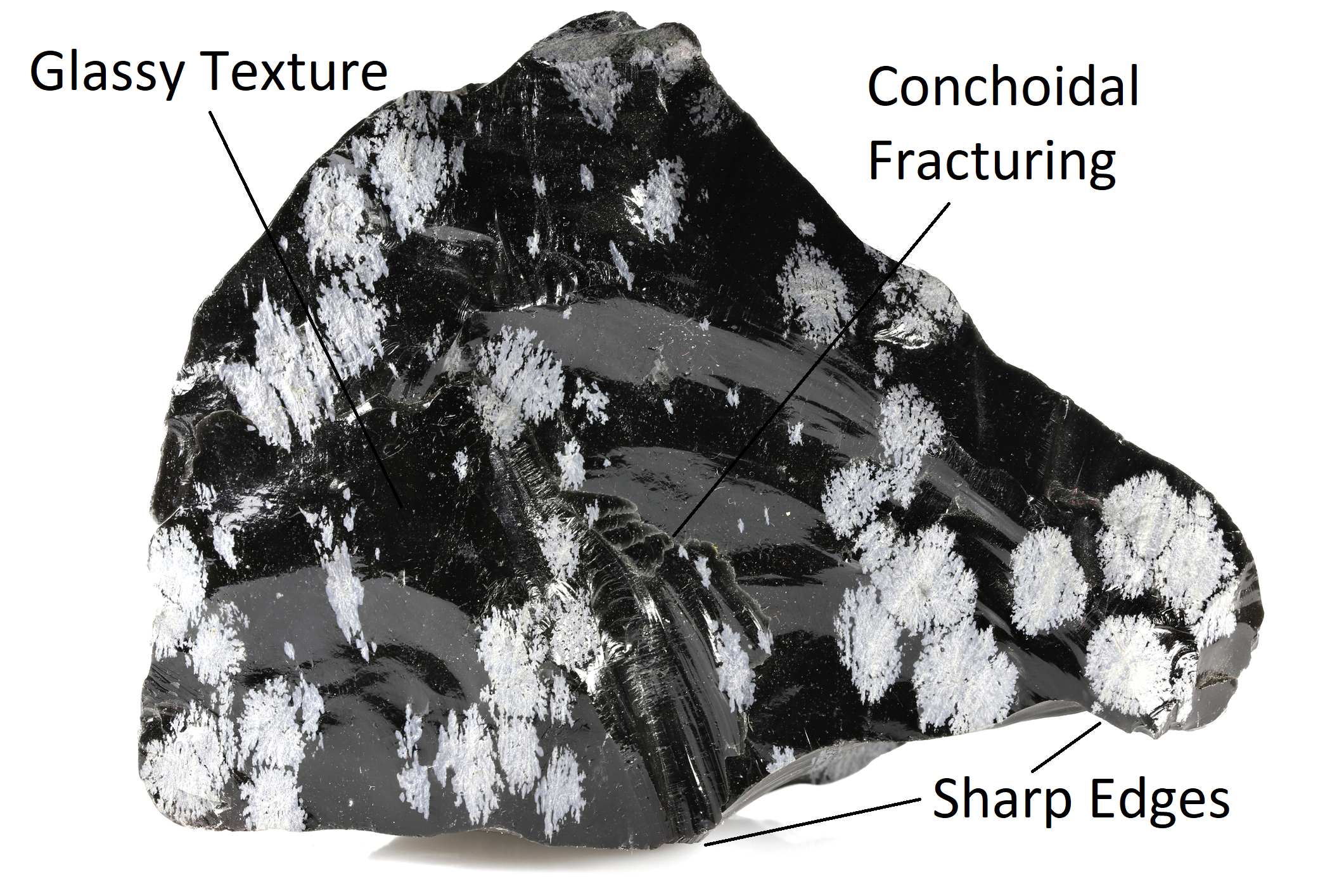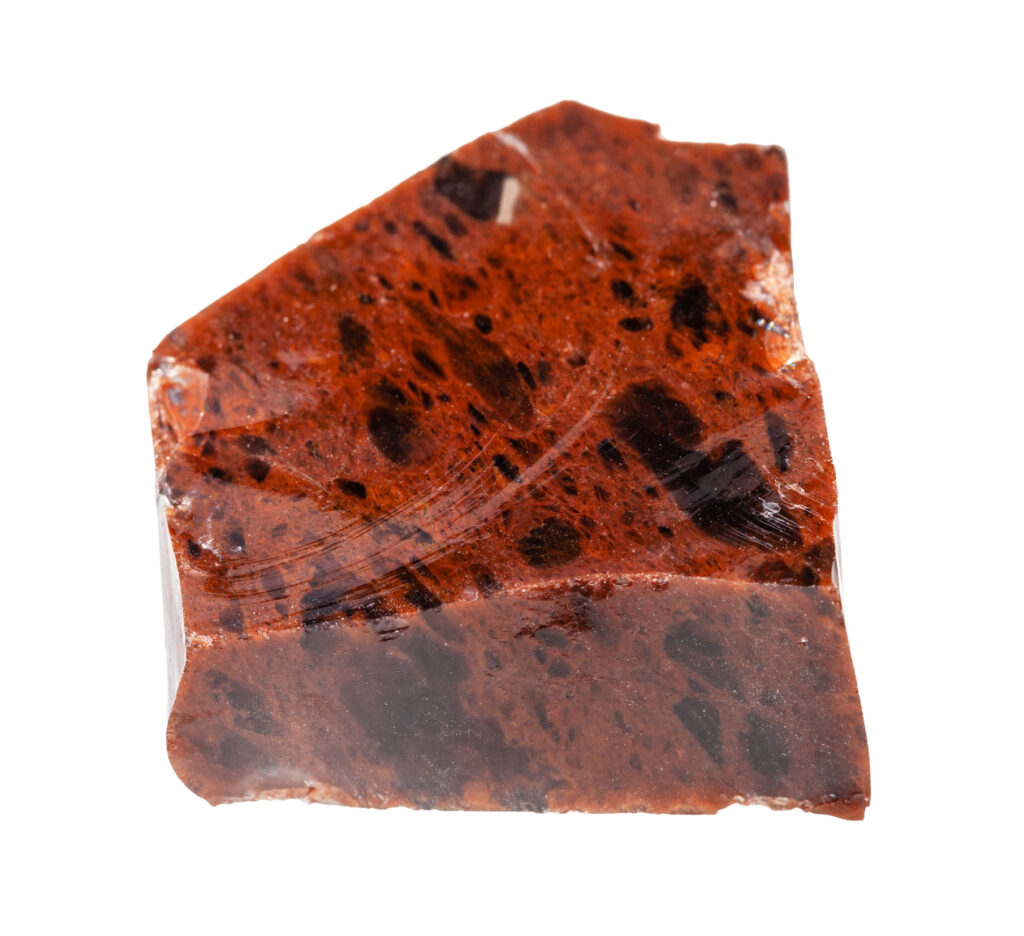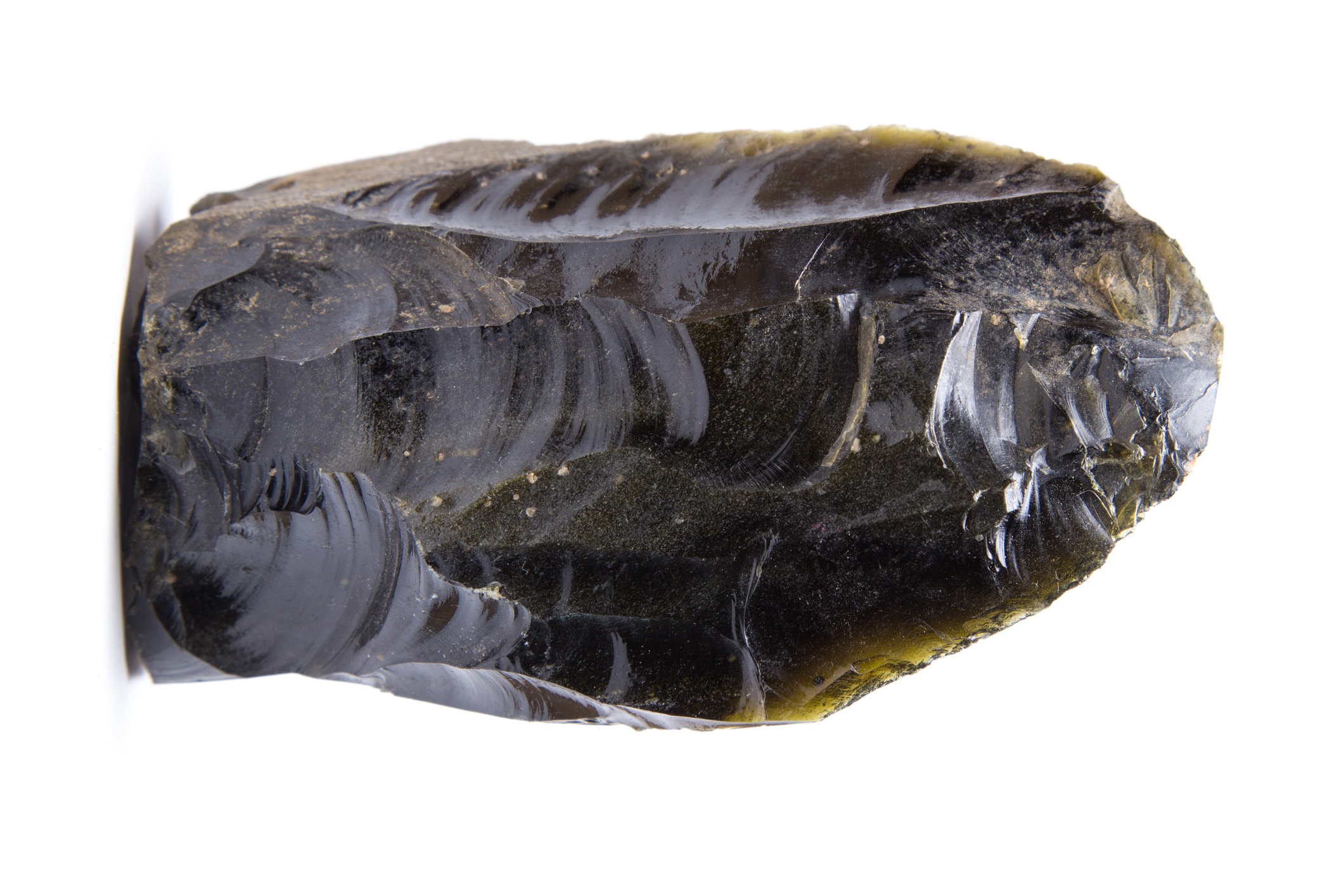Most people are familiar with obsidian thanks to its distinct glassy appearance. It is very popular with collectors, and it has plenty of practical applications. It can be found in specific locations all around the world, making it relatively accessible to collectors.
When most people think of obsidian they picture a black, glassy volcanic rock. While this is generally accurate, there is a lot more intricacy and variety when it comes to obsidian which can sometimes make it more difficult to identify. However, identifying obsidian and its many varieties is a relatively simple process once you know what to look for.
Obsidian is a glassy, extrusive igneous rock with a felsic composition, and is typically black in color but may also be rust-red or display whiteish ‘snowflake’ inclusions. It often displays conchoidal fracturing with very sharp edges. Obsidian is made from the rapid cooling of silica-rich lava.
While obsidian is a clearly defined rock type, there are many different varieties that can appear quite different from one another. I’ll walk you through how to identify obsidian, what different varieties look like, and where it can be found.
What Does Obsidian Look Like?
Most people with a passing knowledge of geology are familiar with obsidian (or at least the most common variety of obsidian). However, sometimes obsidian isn’t as readily identifiable as you might think. It can grade into other rock types, making it difficult to distinguish.
Perhaps you have found a less common variety that doesn’t match your preconceived notion of what obsidian looks like. So, what exactly does obsidian look like?
Obsidian is a glassy-looking, very fine-grained (aphanitic) rock that is usually black but may also be translucent, rust-red, dark green, or iridescent. Inclusions of white ‘snowflakes’ are common. Obsidian is very smooth, with scoop-shaped conchoidal fractures that often result in sharp edges when broken.

Pro Tip: I have created the best rock identification system you’ll find anywhere. It’s made to help everyone from brand new hobbyists to university Geology students, and includes an eBook, digital tools, a video tutorials. Find out more here!
While all obsidian meets this general description, there is a pretty wide spectrum of obsidian that can look significantly different from one another. Their differences in appearance are primarily driven by the impurities contained within the silica-rich magma at the time of formation.
Color is Driven by Impurities
Obsidian primarily consists of silica which, given more time to crystallize, would become quartz crystals. A typical obsidian specimen contains about 70% silica, with the remainder consisting of other elements like aluminum, sodium, and oxygen. It is these impurities that give obsidian its color, and depending on their relative amounts that color can vary from location to location.
Black obsidian, which is the most common and well-known variety, occurs when there are relatively large amounts of tiny inclusions of mafic (dark) minerals like hornblende, pyroxene, and magnetite. Even black obsidian is translucent – meaning light will pass through it. If you hold up a small flashlight behind a piece of obsidian you can see through even the darkest obsidian specimens.
Red or rust-red obsidian occurs when there are microscopic crystals of minerals like limonite or hematite. It is common for rust-red coloration to be mixed with black, giving the obsidian a splotchy appearance. This variety is often referred to as ‘mahogany obsidian’ due to its resemblance to the wood of the same name.
Other colors of obsidian are possible based on the types of impurities in the cooling lava. Rainbow obsidian (one of my favorites) is likely the result of various types of microscopic feldspar crystals aligning themselves preferentially during cooling and solidification.
Pro Tip: To get a better look at the crystals in your rocks and help with identification I highly recommend picking up a good geologist’s hand lens. I use this one that I got on Amazon.
Transparent or nearly clear obsidian is very rare, and requires an extremely silica-rich lava with little to no impurities.
The white coloration seen in snowflake obsidian is a result of a secondary process that occurs after the obsidian’s original formation. The glassy texture of obsidian is very unstable, and over millions of years, the silica will reorganize itself to form radial quartz crystals that look like snowflakes. Over enough time this causes the obsidian to lose the glassy appearance over much of its surface.
Texture of Obsidian
One of the defining features of obsidian’s appearance is its texture. All obsidian is glassy and very fine-grained, meaning that you cannot see the individual crystals in the rock, even with high-powered magnification.
Glassy texture is a sub-texture of ‘aphanitic’, and it forms when lava cools very quickly on or near the Earth’s surface, denying the crystals enough time to nucleate and grow before becoming completely solidified.
As long as the specimen is clean and free of dirt or dust, the surface of obsidian will feel very smooth and even slippery to the touch. The exception is snowflake obsidian, that can sometimes feel a bit rougher due to the re-organized quartz crystals (snowflakes).
How to Identify Obsidian
Obsidian is so distinct looking and relatively recognizable that you might think that identifying it is a trivial matter. While that is often the case, that mindset often leads people to misidentify other rock types as obsidian. It is important to take a more methodical approach when identifying obsidian.
To identify obsidian, first look for a glassy texture with no visible grains in the matrix, even under magnification. Observe the surface of the rock and look for conchoidal fractures and sharp edges. Finally, hold the rock to a light source to check that it is translucent, allowing light to pass through.
A rock must meet all of these requirements to be considered obsidian:
- Igneous – Formed from cooling lava, with interlocking crystal grains.
- Very Fine-grained – Glassy and aphanitic texture with crystals invisible even under magnification
- Felsic Mineralogy – High quartz and feldspar content
- Conchoidal Fracturing – Scoop-shaped surface when broken, common to all glasses

If your rock meets all of those criteria then it is very likely obsidian, or at least something very closely related. People sometimes make the mistake of confusing manmade glass for obsidian, but there are some ways to tell if you have the real thing or not.
Tip: This article is part of my igneous rock identification series. To read more about how to identify all igneous rocks, check out my article here.
Manmade glass is usually brightly colored or clear and has very few impurities aside from those intended to give it its color. It will be very uniform throughout, which only the rarest and purest forms of obsidian can come close to matching. The setting in which you find your rock should be telling. There is likely to be quite a bit of obsidian around if there is any at all, and it will be in a location with a known history of vulcanism.
What Is Obsidian Made Of?
As I mentioned above, obsidian is largely defined by specific makeup. All rocks are at least partially defined by their mineralogy, but obsidian is something of a special case. Some people don’t even classify obsidian as a rock at all!
Since obsidian is made of volcanic glass, it isn’t actually made up of minerals. Rather, obsidian can be classified as a mineraloid because it shares many of the same characteristics as rocks and minerals but it lacks any defined crystal structure.
Practically speaking, obsidian is as much a rock as any other rock type you’ll find in nature. It is simply the unique lack of discernible crystal structures that gives it this special designation which is, for our purposes, a rather pedantic footnote.
So, if obsidian isn’t made of crystals or minerals, what is it made from?
Obsidian is made mostly made of non-crystallized silica (SiO2), typically about 70% of the total rock volume. It is chemically very similar to felsic rocks like rhyolite and granite, containing elements like aluminum, sodium, and oxygen. Tiny gas bubbles and some water are commonly trapped in the rock matrix.

It is important to state again that obsidian is not made of minerals. Part of the definition of a mineral is that it has a defined crystal structure, which is not present in obsidian. A rock is technically defined as being made of one or more minerals, so therefore technically obsidian is not really a rock.
But again, for most rockhounds and collectors this distinction is not relevant. Obsidian is made of glassy mineraloids, primarily silica with some impurities mixed in. The end result is a rock in almost every practical sense of the word.
Where Is Obsidian Found?
Obsidian is a fairly common rock that can be found in localities all around the world. The magma type from which it forms is often found in a specific but relatively common geologic setting, making obsidian somewhat accessible to collectors and enthusiasts everywhere.
Obsidian is most commonly found in old volcanic fields at the edges of felsic lava flows where rapid cooling against air and water is likely to occur. In the U.S., popular collecting sites include Glass Butte in Oregon and many other sites in the Cascades, plus several localities in the central Appalachians.
Obsidian isn’t as widespread as you might think. This is partially because it is only partially stable on the Earth’s surface, so it changes and degrades over time. It is uncommon to find quality obsidian much older than 20 million years or so. That may sound like a long time, but geologically speaking that’s not a very long window.
Sometimes you may find isolated pieces of obsidian in places you might not expect in the form of arrowheads or other tools. The unique properties of obsidian made it a valuable commodity for trading, so it was often transported a long way from its original source.
How Does Obsidian Form?
We’ve learned all about what obsidian looks like, what it is composed of, and generally where it’s found, but I have only briefly touched on how it’s actually formed. The creation of obsidian is a fascinating process that always follows a few simple rules.
Obsidian forms from the very rapid cooling of felsic, silica-rich lava near or above the Earth’s surface. This lava is extremely viscous which, combined with the rapid cooling rate, prevents crystals from forming before the rock solidifies. Obsidian is essentially frozen felsic lava with no visible crystals.
There is very little variation when it comes to the texture of obsidian, largely due to how it forms. The structure (or, more accurately, the lack thereof) of volcanic glass is amorphous and unorganized and it is essentially the same from location to location.
The magma/lava from which obsidian forms can undergo viscous flow which sometimes gives it a streaked appearance, but for the most part it appears uniform throughout. Obsidian flows move very slowly and don’t mix well which, when combined with rapid cooling, results in very uniform rocks.
Because obsidian forms as one solid mass, it usually contains no internal structures like bedding or banding. It looks the same from all directions and you can’t tell which direction was ‘up’ at the time of crystallization. This is called a ‘massive’ rock.

What Is Obsidian Used For?
Obsidian has been in use for thousands of years because of its unique attributes. It was one of the most sought-after and versatile rocks used in the ancient world, and continues to have practical applications even today.
Obsidian has traditionally been used for the creation of blades and arrowheads, but also saw extensive use for primitive mirrors and decorative items including jewelry. Today, it continues to be used for surgical applications due to its incredibly sharp edges. It remains popular with collectors as a gemstone.
Obsidian is not as durable as most rocks. Its glassy texture means that it is very brittle and susceptible to breakage. While obsidian blades are many times sharper than even the sharpest steel blades, they are much more easily broken so must be handled with care.
One of my favorite uses for obsidian is as a filter for the viewing of solar eclipses. You can purchase an obsidian disc like this one from Amazon and use it to protect your eyes during a solar eclipse. Obviously, take all necessary precautions to protect your eyes from direct sunlight, but this is the best and coolest way I’ve ever seen to view an eclipse. You can also use this disc as a mirror!
This article is part of my rock identification series. To learn more about identifying rocks, check out my full in-depth guide here.
